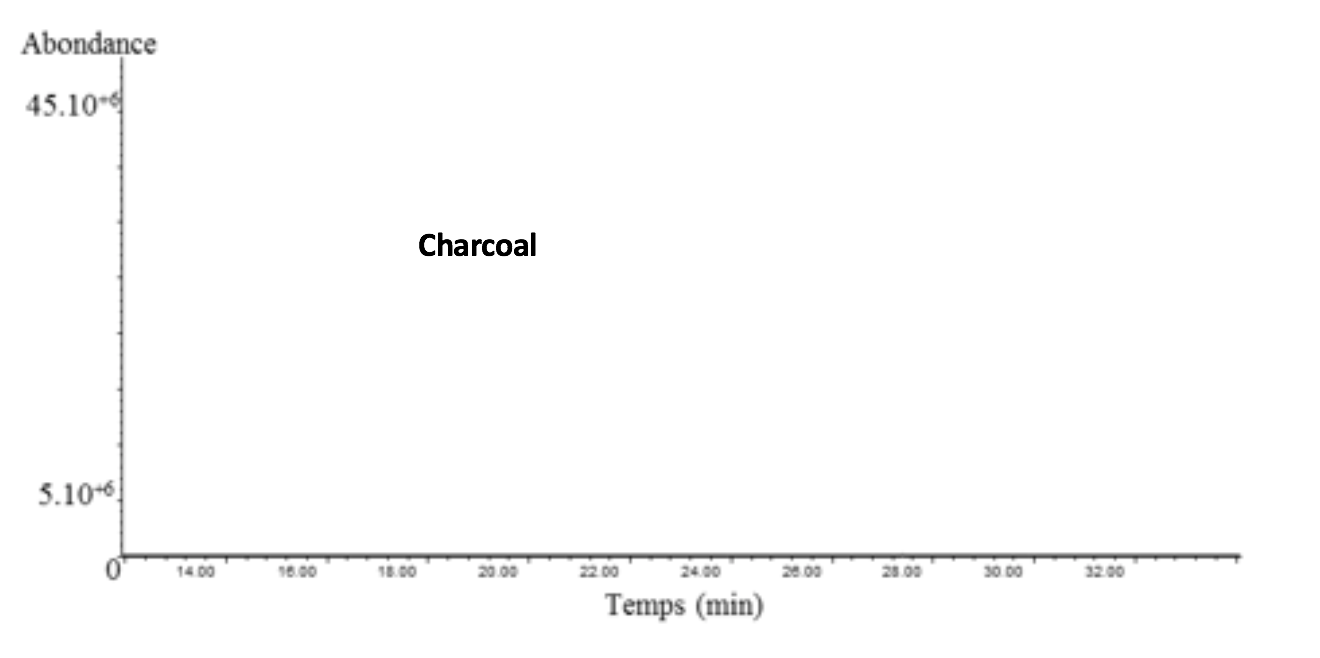Research studies
Studies performed with different natural spices: proof of concept Different spices were scientifically assessed in several famous laboratories to select the most effective: cinnamon. Studies based on sensory analyses and odour quantification using laboratory-based chromatographic analyses were conducted to validate the choice of cinnamon. Sensory studies Several sensory studies were performed by the Institut Curie on different models. The best representation of the clinical situation was achieved via an in vitro study using necrotic tumoral biopsies. A panel of 28 participants characterized necrotic odours using a sensory perception scale ranging from an unpleasant to a very pleasant smell without the use of an anti-odour active substance, then with charcoal or spices (30 mg of anti-odour active substance for 200 mg of necrotic tissue).
The study demonstrated that the sensory perception of malodorous wounds can be significantly improved by the use of cinnamon. Chromatographic analysis In collaboration with ESPCI Paris (the Ecole Supérieure de Physique et de Chimie Industrielles de la ville de Paris), and Chimie Paris, chromatographic analyses were conducted which showed that some spices have good adsorption properties, i.e. a high capacity to bind malodorous organic volatile components (VOCs). In vitro analytical tests were performed comparing the adsorption profiles of spices and charcoal for specific malodorous components (VOCs) of necrotic tissue. This model demonstrated a higher level of adsorption for cinnamon compared to the other spices tested. In addition to capturing VOCs, cinnamon releases pleasant VOCs. This combination of properties makes this spice a very valuable component in the treatment of bad smells.

VOCs from the comparison of charcoal substance from anti-odour dressing & cinnamon powder (extract from the patent “an odour adsorption device”). Odorous components (represented by peaks) are emitted by cinnamon but not by charcoal (ESPCI). Cinnamon dressing prototypes prepared by the Institut Curie were also used on top of primary absorbent dressings by 6 patients after failure of symptomatic treatment and evaluated through an independent study (Thuleau, 2017). 83% of these patients (confirmed by caregivers) felt that odours had been completely eliminated. Taken together, these experimental investigations led to the conclusion that cinnamon is the most effective natural spice of the different spices tested.
Development of the secondary anti-odour dressing with cinnamon
This discovery led to the development of an anti-odour secondary dressing containing cinnamon powder via a collaboration between CEMAG CARE, Chimie Paris, ESPCI Paris and the Institut Curie, Paris. This work resulted in the development of the Cinesteam® dressing.
The design of Cinesteam®, based on the natural properties of cinnamon, was developed to allow the absorption of exudates, the adsorption of bad odours and the release of a pleasant cinnamon fragrance to improve the lives of patients and carers.
References:
Wilkes LM, Boxer E, White K. The hidden side of nursing: why caring for patients with malignant malodorous wounds is so difficult. J Wound Care. 2003; 12 (2):76-80.Lazelle-Ali C. Psychological and physical care of malodorous fungating wounds. Br J Nurs. 2007; 16 (15):S16-S24.
Da Costa Santos CM, De Mattos Pimenta CA, Nobre MRC. A systematic review of topical treatments to control the odor of malignant fungating wounds. J Pain Symptom Manage. 2010;39 (6):1065-1076.
Gethin G, Grocott P, Probst S, Clarke E. Current practice in the management of wound odor : an international survey; International Journal Nursing studies 2014 June Jun;51(6):865-74
Akhmetova, A, Saliev, T. A comprehensive review of topical odor-controlling treatment options for chronic wounds; J Wound Ostomy Continence Nurs. 2016 Nov; 43(6):598–609.
Fromentin I., Hurgon A., Dugay J., et al. Odeurs, plaies et curcuma : hypothèses et pratique clinique. Revue francophone internationale de recherche infirmière, mars 2015, n°1, pp 23-30. Thuleau A, Duguay J., Semetey V., Fromantin I. traitement des plaies malodorantes par un dispositif médical aux épices revue Francophone de Cicatrisations 2017;1:51. Extrait du brevet “Dispositif pour l’adsorption d’odeurs” (Ref : WO 2018/020141)
Cinesteam is a secondary anti-odour absorbent dressing manufactured by Cemag Care.
Cinesteam is intended for the management of malodorous wounds.
This medical device (class I) is a regulated healthcare product, which, pursuant to this regulation, bears the CE marking.
Read the leaflet carefully before use.
ML-CIN-FR-1019 created on 10/2019.
